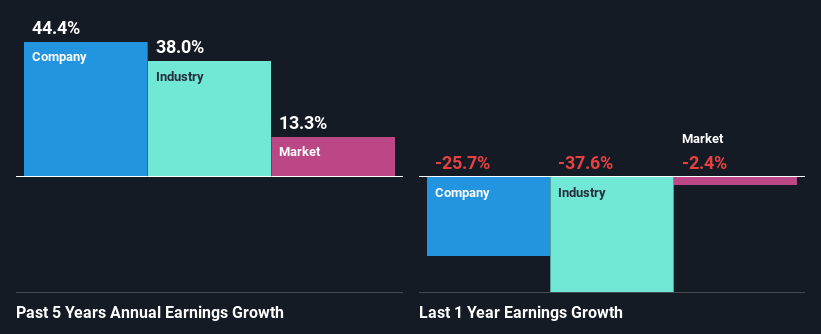Diamondback Energy, Inc.'s (NASDAQ:FANG) Stock Has Been Sliding But Fundamentals Look Strong: Is The Market Wrong?
With its stock down 3.5% over the past month, it is easy to disregard Diamondback Energy (NASDAQ:FANG). But if you pay close attention, you might gather that its strong financials could mean that the stock could potentially see an increase in value in the long-term, given how markets usually reward companies with good financial health. Specifically, we decided to study Diamondback Energy's ROE in this article.
ROE or return on equity is a useful tool to assess how effectively a company can generate returns on the investment it received from its shareholders. In simpler terms, it measures the profitability of a company in relation to shareholder's equity.
See our latest analysis for Diamondback Energy
How To Calculate Return On Equity?
The formula for ROE is:
Return on Equity = Net Profit (from continuing operations) ÷ Shareholders' Equity
So, based on the above formula, the ROE for Diamondback Energy is:
19% = US$3.4b ÷ US$18b (Based on the trailing twelve months to March 2024).
The 'return' is the yearly profit. So, this means that for every $1 of its shareholder's investments, the company generates a profit of $0.19.
What Has ROE Got To Do With Earnings Growth?
Thus far, we have learned that ROE measures how efficiently a company is generating its profits. Depending on how much of these profits the company reinvests or "retains", and how effectively it does so, we are then able to assess a company’s earnings growth potential. Assuming everything else remains unchanged, the higher the ROE and profit retention, the higher the growth rate of a company compared to companies that don't necessarily bear these characteristics.
Diamondback Energy's Earnings Growth And 19% ROE
To start with, Diamondback Energy's ROE looks acceptable. Further, the company's ROE is similar to the industry average of 18%. Consequently, this likely laid the ground for the impressive net income growth of 44% seen over the past five years by Diamondback Energy. However, there could also be other drivers behind this growth. Such as - high earnings retention or an efficient management in place.
Next, on comparing Diamondback Energy's net income growth with the industry, we found that the company's reported growth is similar to the industry average growth rate of 38% over the last few years.
Earnings growth is an important metric to consider when valuing a stock. The investor should try to establish if the expected growth or decline in earnings, whichever the case may be, is priced in. By doing so, they will have an idea if the stock is headed into clear blue waters or if swampy waters await. Is Diamondback Energy fairly valued compared to other companies? These 3 valuation measures might help you decide.
Is Diamondback Energy Efficiently Re-investing Its Profits?
The three-year median payout ratio for Diamondback Energy is 37%, which is moderately low. The company is retaining the remaining 63%. This suggests that its dividend is well covered, and given the high growth we discussed above, it looks like Diamondback Energy is reinvesting its earnings efficiently.
Besides, Diamondback Energy has been paying dividends over a period of six years. This shows that the company is committed to sharing profits with its shareholders. Based on the latest analysts' estimates, we found that the company's future payout ratio over the next three years is expected to hold steady at 41%. Regardless, Diamondback Energy's ROE is speculated to decline to 12% despite there being no anticipated change in its payout ratio.
Conclusion
In total, we are pretty happy with Diamondback Energy's performance. Particularly, we like that the company is reinvesting heavily into its business, and at a high rate of return. Unsurprisingly, this has led to an impressive earnings growth. That being so, a study of the latest analyst forecasts show that the company is expected to see a slowdown in its future earnings growth. To know more about the latest analysts predictions for the company, check out this visualization of analyst forecasts for the company.
Have feedback on this article? Concerned about the content? Get in touch with us directly. Alternatively, email editorial-team (at) simplywallst.com.
This article by Simply Wall St is general in nature. We provide commentary based on historical data and analyst forecasts only using an unbiased methodology and our articles are not intended to be financial advice. It does not constitute a recommendation to buy or sell any stock, and does not take account of your objectives, or your financial situation. We aim to bring you long-term focused analysis driven by fundamental data. Note that our analysis may not factor in the latest price-sensitive company announcements or qualitative material. Simply Wall St has no position in any stocks mentioned.

 Yahoo Finance
Yahoo Finance 
